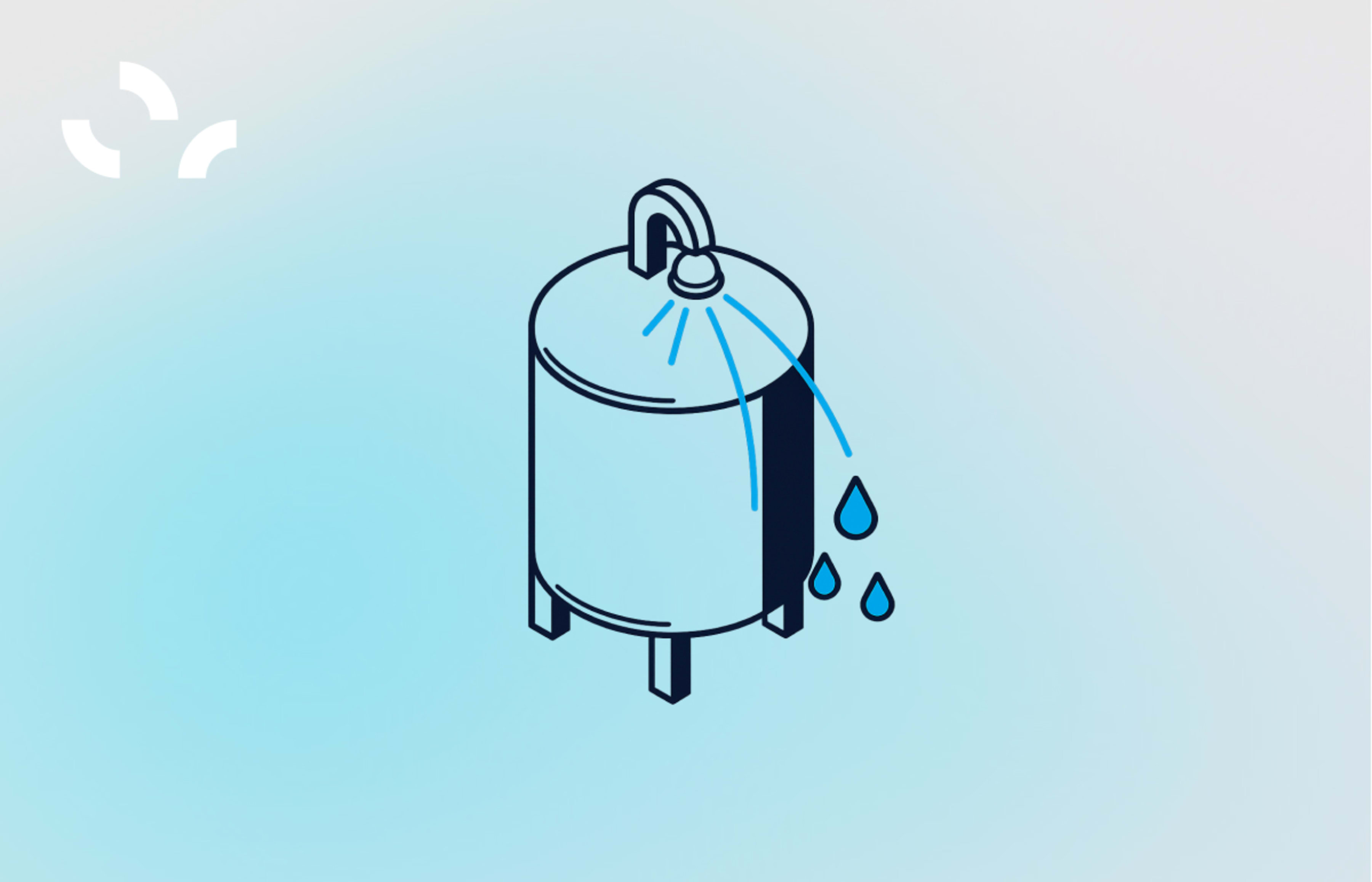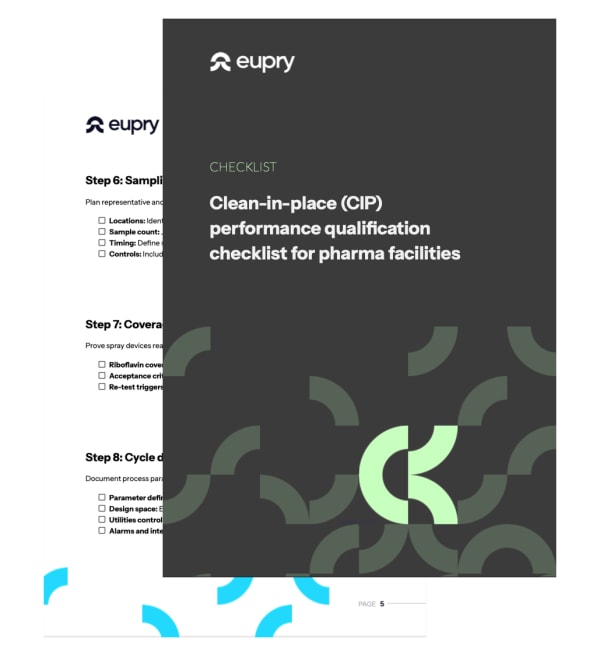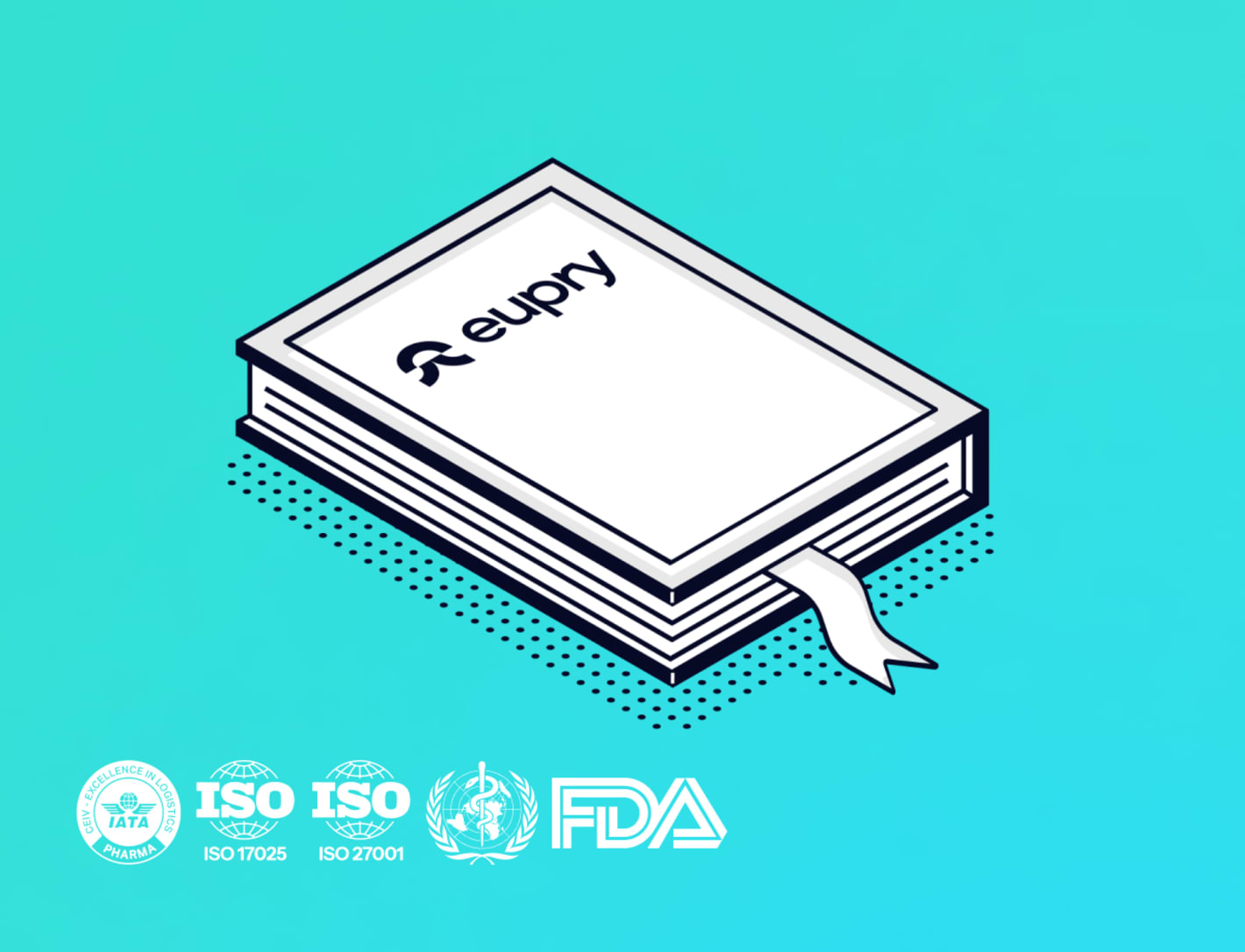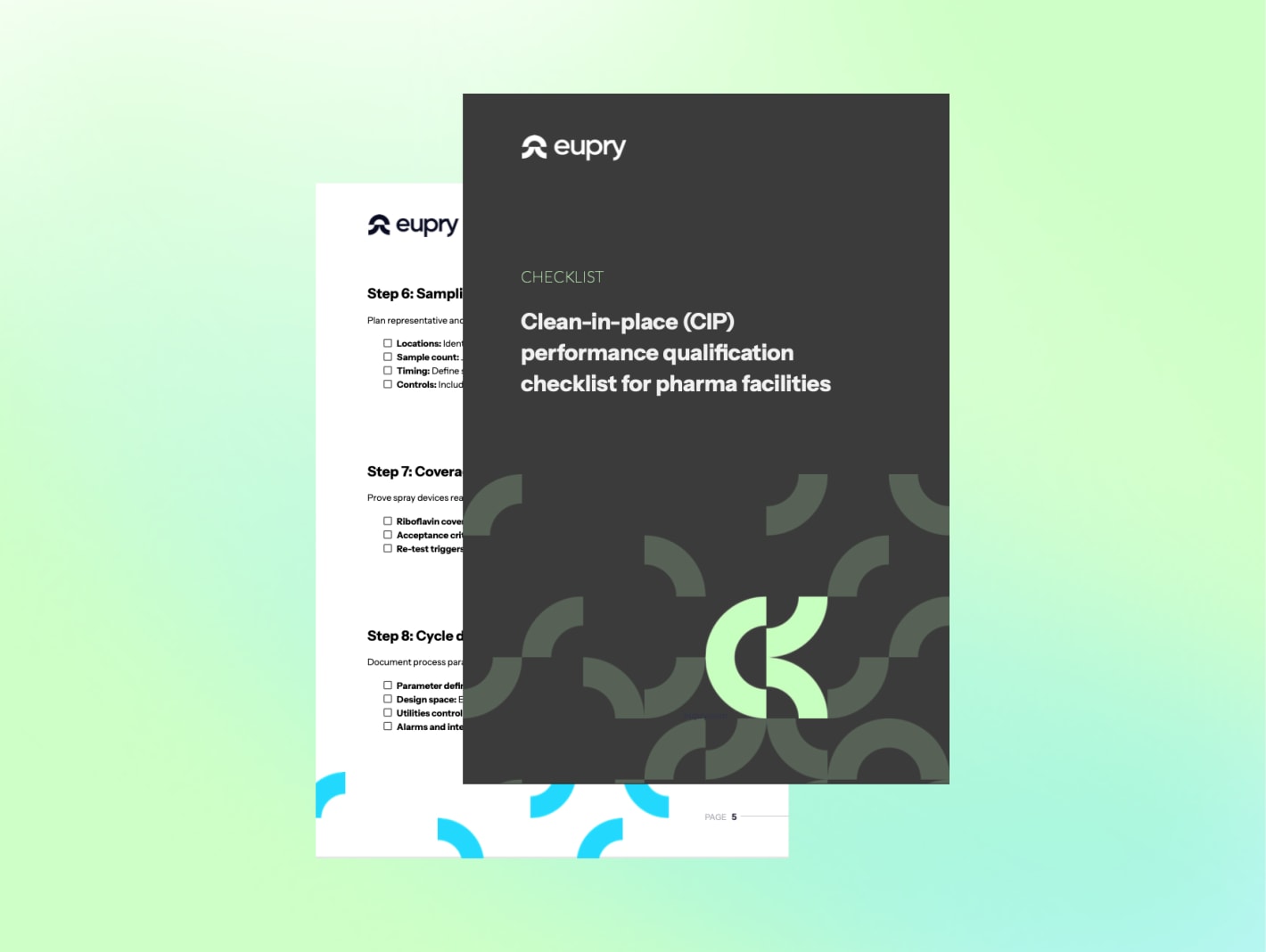Clean in place (CIP) in pharmaceuticals and biotech

Adam Hartmann-Kruckow
Complete GMP compliance guide
Understand proven best practices to design, validate, and run CIP systems that prevent cross-contamination, protect product quality, and keep you compliant — all without slowing production.
An easy‑to‑use, GxP‑aligned template covering all the steps to plan and execute CIP qualification.

Also read: Introduction: What is steam-in-place (SIP) validation?
Clean-in-place (CIP) keeps product contact surfaces clean, consistent, and compliant without disassembly. This guide shows how regulated manufacturers plan, validate, document, and continuously verify CIP under GMP.
What is clean-in-place (CIP) in pharma and biotech?
CIP is an automated cleaning process that removes product residues from equipment internals using programmed cycles of rinse, detergent, and final rinse. In GMP environments, CIP must be designed and validated so that residues are consistently removed to pre‑defined, risk‑based limits. CIP does not sterilize; sterilization is handled separately by SIP.
- Purpose in GMP: Reduce cross‑contamination risk and ensure reproducible cleaning between campaigns and product changeovers.
- Typical scope: Tanks, bioreactors, transfer lines, filters, heat exchangers, and other closed systems.
- Regulatory frame: Align your program with a science‑ and risk‑based approach to validation and lifecycle verification.
Also read: Complete guide to steam-in-place (SIP) validation in GxP, and CIP vs SIP: Differences and GMP uses in pharma manufacturing

Download your CIP performance qualification checklist
A practical blueprint to help you conduct clean-in-place (CIP) qualification reliably and aligned with regulatory expectations of GMP.
How do you set risk-based acceptance criteria for cleaning validation?
Risk‑based acceptance criteria ensure patient safety and product quality. These criteria should be scientifically justified and defendable to regulators.
- HBEL/PDE to MACO: Start with health‑based exposure limits (HBEL) or permitted daily exposure (PDE) values. Convert to maximum allowable carryover (MACO) by factoring in equipment surface area, batch size, and worst‑case scenarios.
- Detergent residues: Define safe residual levels based on toxicological data and operator exposure considerations.
- Visual clean: Establish clear pass/fail conditions for visual inspections, including lighting levels and inspection distances.
- Microbial/endotoxin: Apply where there is a risk of microbial contamination, particularly for sterile or high‑risk processes.
- Documentation: Include full calculations, assumptions, and scientific references in your validation report.
Also read: Complete guide to steam-in-place (SIP) validation in GxP
Which sampling and analytical methods should you choose?
The choice of method affects the reliability and credibility of your results. Regulators expect sampling and analysis to be fit for purpose and supported by recovery data and method performance evidence.
- Swab vs rinse: Use swabs for defined, hard‑to‑reach locations and rinse for broad coverage of internal surfaces. Decision rationale: Tie the choice to residue chemistry, access, and the ability to achieve quantitation at or below limits.
- Analytical options: TOC: broad organic detection for many actives and detergents. Conductivity: ionic residues and final‑rinse verification. HPLC/UPLC or specific assays: when chemical specificity is required by risk or when TOC/conductivity are not selective enough.
- Recovery studies: Establish recovery factors for each surface/solvent combination and apply corrections consistently in calculations.
- Interferences: Evaluate how detergents, buffers, or excipients influence TOC/conductivity or specific assays; mitigate with method choice or additional rinses.
- Controls and blanks: Include field blanks, spiked recoveries, and calibration checks to demonstrate method performance in routine use.
How do you design and prove coverage for CIP systems?
Coverage ensures mechanical action reaches all product‑contact surfaces. Design decisions on spray devices, drainability, and flow paths must be verified under worst‑case conditions and maintained through change control.
- Cycle design: Define pre‑rinse, wash, intermediate rinse, and final rinse with proven acceptable ranges for time, temperature, flow, pressure, and concentration; document design space and set points.
- Spray device placement: Position static or rotating spray devices to avoid shadowing; record device type, orientation, and required flow/pressure window.
- Coverage verification: Use a riboflavin coverage test (or equivalent) to visually confirm full wetting; capture photo evidence and apply pre‑defined pass/fail criteria.
- Flow and pressure checks: Verify minimum utilities at point‑of‑use across the system; include edge‑of‑range challenges to show robustness.
- Re‑testing triggers: Repeat coverage tests after internal modifications, device changes, or significant utilities adjustments.
Also read: Complete guide to steam-in-place (SIP) validation in GxP and Designing CIP systems for regulated pharma and biotech
How should IQ/OQ/PQ be planned for CIP?
A structured plan links installation, operation, and performance to a lifecycle that maintains control. Each stage should be risk‑based and clearly justified rather than relying on fixed numbers of tests.
- IQ (installation qualification): Verify as‑built configuration against URS and drawings, materials certificates, and correct instrument installation and calibration; document traceability to component IDs.
- OQ (operational qualification): Challenge recipes, alarms, and interlocks at normal and edge‑of‑range conditions; verify utilities and sensor performance meet the defined operating window.
- PQ (performance qualification): Execute risk‑based runs covering worst‑case products, soils, and locations; include analytical sampling per the plan and show results meet acceptance criteria under routine conditions.
- Lifecycle linkage: Define continued verification (periodic review, trending, and deviation review) and clear requalification triggers.
- Change control: Route recipe or hardware changes through quality review with documented impact assessment on limits, methods, and sampling.
Also see: CIP performance qualification checklist for pharmaceutical facilities
What are common pitfalls and how do you fix them?
- Rinse‑only proof: Relying on conductivity alone without a rationale. Fix: Justify with residue chemistry and support with TOC or specific assays; document the decision.
- Weak recovery: Low or unverified swab/rinse recovery. Fix: Perform recovery studies on representative surfaces and apply recovery factors in calculations.
- Coverage shadows: Spray device shadowing or insufficient flow. Fix: Reposition devices, adjust flow/pressure, or add devices; re‑test with riboflavin and update drawings.
- Uncontrolled hold times: Dirty or clean hold times exceeded. Fix: Define limits with rationale, track them in production, and require re‑cleaning or SIP when limits are exceeded.
- Performance drift: Gradual increase in residue results over time. Fix: Trend results and utilities data; plan preventive maintenance and requalification when trends approach limits. Consider continuous data approaches for easier trending such as Continuous temperature mapping solution
What documentation and data integrity do inspectors expect?
- ALCOA+: Build recordkeeping so data are attributable, legible, contemporaneous, original, accurate, complete, consistent, enduring, and available.
- Electronic records and signatures: Use validated systems with role‑based access, time‑synchronization, and audit trail review. Also see 9 questions: Ensuring FDA 21 CFR Part 11 compliant temperature monitoring in pharma](/regulations-temperature-compliance/21-cfr-part-11/).
- Audit readiness: Align documentation, logs, and evidence with how auditors sample during inspections.
When should you move from CIP to SIP?
- Aseptic or sterile boundary present: If equipment feeds an aseptic process or directly contacts sterile product, add SIP after validated CIP to achieve the required sterility assurance level.
- Bioburden or endotoxin risk: If bioprocess media, proteins, or high‑nutrient residues are present, implement SIP after CIP to control microbial growth and pyrogens.
- Risk assessment outcome: When risk analysis shows unacceptable microbiological risk with cleaning alone, plan a validated SIP cycle as part of the routine sequence.
- Change of use or product class: When equipment switches from non‑sterile to sterile applications, or to products with higher risk profiles, require SIP in the new validated state.
- Hold times and exposure: If clean hold times cannot be maintained or are repeatedly exceeded, incorporate SIP prior to use to restore a defined microbiological state.
Learn more about the difference between CIP and SIP.
Also read: Complete guide to steam-in-place (SIP) validation in GxP and Introduction to steam in place (SIP)
Templates and further reading
- CIP performance qualification checklist for pharmaceutical facilities
- Complete guide to steam-in-place (SIP) validation in GxP
- CIP vs SIP: Differences and GMP uses in pharma manufacturing
- Designing CIP systems for regulated pharma and biotech
- 21 CFR Part 11 checklist
- Continuous temperature mapping solution

Frequently asked questions about clean-in-place (CIP)
13-steps: Clean-in-place performance qualification
Get a step‑by‑step checklist to help you conduct clean‑in‑place (CIP) qualification reliably, efficiently, and in line with GMP requirements.
